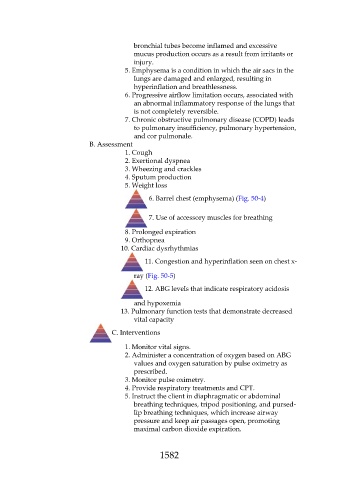Page 1582 - Saunders Comprehensive Review For NCLEX-RN
P. 1582
bronchial tubes become inflamed and excessive
mucus production occurs as a result from irritants or
injury.
5. Emphysema is a condition in which the air sacs in the
lungs are damaged and enlarged, resulting in
hyperinflation and breathlessness.
6. Progressive airflow limitation occurs, associated with
an abnormal inflammatory response of the lungs that
is not completely reversible.
7. Chronic obstructive pulmonary disease (COPD) leads
to pulmonary insufficiency, pulmonary hypertension,
and cor pulmonale.
B. Assessment
1. Cough
2. Exertional dyspnea
3. Wheezing and crackles
4. Sputum production
5. Weight loss
6. Barrel chest (emphysema) (Fig. 50-4)
7. Use of accessory muscles for breathing
8. Prolonged expiration
9. Orthopnea
10. Cardiac dysrhythmias
11. Congestion and hyperinflation seen on chest x-
ray (Fig. 50-5)
12. ABG levels that indicate respiratory acidosis
and hypoxemia
13. Pulmonary function tests that demonstrate decreased
vital capacity
C. Interventions
1. Monitor vital signs.
2. Administer a concentration of oxygen based on ABG
values and oxygen saturation by pulse oximetry as
prescribed.
3. Monitor pulse oximetry.
4. Provide respiratory treatments and CPT.
5. Instruct the client in diaphragmatic or abdominal
breathing techniques, tripod positioning, and pursed-
lip breathing techniques, which increase airway
pressure and keep air passages open, promoting
maximal carbon dioxide expiration.
1582

